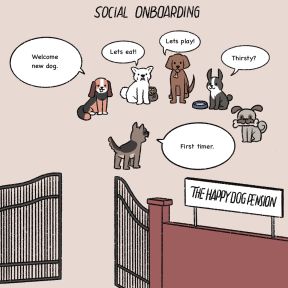Vulnerability to Anxiety
Researchers believe that anybody can experience a bout of debilitating anxiety. But some people seem to be dispositionally inclined to anxiety: Their defense systems—possibly tuned by genes or temperament, possibly by early experience, possibly by over- or underactivity of some area of the brain—are poised to over-interpret neutral situations as threatening or to overreact to threatening situations.
On This Page
- What role do genes play in anxiety?
- Are there biological traits that make people vulnerable to anxiety?
- How does childhood adversity create vulnerability to anxiety?
- How does stress affect anxiety?
- Do neurotransmitters play a role in anxiety?
- How does anxiety start?
- How does the anxious brain differ from the normal brain?
- Is it possible to rewire the anxious brain with talk therapy?
It is not clear how much of a role genetics plays in causing excessive anxiety. Studies show that children with anxiety disorders are twice as likely as other children to have parents with anxiety disorders; but it’s an open question whether such findings reflect biological or environmental transmission. Parental anxiety could be shaping parenting style in a way that contributes to development of anxiety disorders in the young.
Some studies have shown that variations of genes linked to the hypothalamic-pituitary-adrenal axis may create susceptibility to anxiety disorders. This is the system that regulates the fight-or-flight stress response by activating the sympathetic nerve in the face of threat. Overexcitability of any element in the stress response system, as well as shifts in activity of various neurochemicals in the brain and diminished efficiency of nerve circuitry and nerve generation—all play a role in anxiety.
The expression and function of genes can be altered without any changes to the gene structure itself. Such changes, known as epigenetic modifications, can occur as a result of life experiences to create vulnerability to anxiety. For example, in rat pups, lack of maternal care can permanently reset the sensitivity of receptors to stress hormones. If their mothers fail to lick and groom them, the pups grow up to display an exaggerated response to stress hormones and develop psychopathology in response to stress. There is a great deal of evidence that among humans, certain kinds of adverse childhood experience—such as repeated child abuse or neglect—can have a lasting impact on the function of genes (such as those that activate the stress system) to increase the risk of anxiety later on.
There is a temperament seen in a significant percentage of children—as many as 20 percent— that is related to later development of anxiety. Behavioral inhibition shows up early in childhood, as heightened negative reactivity and heightened attention to and wariness of unfamiliar people and situations. It may also involve heightened awareness of internal body states. It makes toddlers and children overly fearful and clingy.
Studies show that behavioral inhibition involves a bias of attention networks in the brain towards threat and away from positive information. While attentional bias toward threat may be the way the nervous system is initially tuned in such infants, that tuning isn’t necessarily fixed. In fact, research indicates that attention is amenable to moderation, and parents may play a big role in shaping it. For example, parents who constantly point out dangers to their children may unwittingly reinforce the attentional bias to threat. Children who learn to flexibly shift their attention from distress may be less in thrall to the attentional bias and less likely to develop anxiety. The evidence indicates that the temperament of behavioral inhibition may make children vulnerable to anxiety but it alone does not mandate its development.
Severe or sustained early life adversity shifts the course of brain development and can lastingly impair emotion regulation and cognitive development. Excessive or prolonged activation of the stress response in childhood, studies show, can sensitize the brain so that it is constantly on the lookout for danger and overresponds to minimal levels of danger. Such brain changes are an attempt at protection—adaptations aimed at promoting safety in dangerous environments. But once children grow up and move out of their early environment, those brain changes remain and can make them feel easily threatened by life’s ordinary challenges. Severe or prolonged childhood adversity has been shown to affect the function of genes important for the wiring of the brain, so that emotional control is difficult—overproducing neural connections in regions such as the amygdala that signal threat and other negative emotions while underendowing neural connectivity in brain areas responsible for behavioral control, reasoning, and planning.
Such rigging of emotion processing circuits leads to heightened emotional reactivity, lack of emotional awareness, and reliance on maladaptive emotion regulation strategies such as rumination and worry. The types of negative childhood experience that give rise to later anxiety include negative family atmosphere; physical, emotional, or sexual abuse; loss of a parent of other loved one; social difficulties; and school experiences such as bullying. Nevertheless, adult brains retain the capacity for neuroplasticity. Although it takes effort, and often the guidance of psychotherapy, people can learn to overcome many of the ill effects of early adversity.
Stress and anxiety overlap in many ways; both are survival strategies that share many psychological and physical actions. Stress can both set off anxiety and be a response to it. Stress can be beneficial to the brain, depending on how intense and long-lasting the stressor is. In brief bursts, stress is a signal to prepare body and brain to adapt to new challenges and circumstances. It fosters alertness and fast learning. Severe or prolonged stress, however, can disrupt many aspects of brain function.
Overproduction of the stress hormone cortisol is especially disruptive to cells in the hippocampus, the brain’s memory center and a key station in the circuitry of anxiety: It is the role of the hippocampus to put into context the signals of threat emanating from an emotionally screaming amygdala so that the prefrontal cortex can decide on the appropriate response. Stress constrains the hippocampus. Sustained stress can also overactivate the amygdala so that it relentlessly sends out signals of alarm that overpower the ability of the prefrontal cortex to subdue them, the source of so much human distress.
The neurotransmitters GABA (gamma-aminobutyric acid) and glutamate, which act largely as opposing forces in the brain—glutamate stimulating the firing of nerve cells and GABA dampening it—are increasingly thought to play significant roles in anxiety. Many lines of evidence indicate that anxiety arises from some disturbance of the brain circuits that regulate the emotional response to potentially threatening stimuli. Through the normal channels of circuitry connecting the emotion-stoking amygdala and the prefrontal cortex (PFC), epicenter of the rational, planning brain, there is constant communication balancing inhibitory and excitatory signals. Both GABA and glutamate are involved in that circuitry.
In anxiety, the PFC is outgunned by the amygdala. Likely brought about by the hormones of stress, GABA receptors that normally keep the amygdala in line undergo changes so that it becomes hyperactive in sending out signals of alarm. Stress may also affect glutamate in such a way to keep the PFC from its normal task of modulating the emotional output of the amygdala. Researchers find that in a specific channel of one-way signaling from the PFC to the amygdala, stress stimulates release of the excitatory neurotransmitter glutamate and shifts the balance of signals transmitted by the PFC towards excitatory signals. The emotional alarm signals emanating from the hyperactivated amygdala, amplified by the excitatory neurotransmitter glutamate, shut down specific groups of nerve cells in the PFC, thereby shutting down the possibility of regulating amygdala hyperactivity. Anxiety reigns.
Anxiety, as well as its older relative fear, is set off by a signal from the amygdala, an ancient part of the brain. It processes emotion-related stimuli and sends out signals that ultimately beget a behavioral response. Fear is the response to an immediate danger. Anxiety, a more cerebral and subjective state, results when the amygdala perceives a vague threat or faces the possibility of an unwanted outcome to a future event. It is dominated by the element of uncertainty.
The amygdala—actually, there are two, and they are tiny, almond-shaped structures, one each in the right and left temporal lobe—is often called “the fear center” of the brain, and it does flag fearful stimuli. But it also plays a role in many other emotions and is a notable participant in pain perception and behavioral aggression. The size of the amygdala, its degree of connectivity to other parts of the brain—stress may boost its connections—and its threshold of activation may naturally vary among people, predisposing to anxiety those with a large amygdala, or stronger connectivity, or with a low threshold of activation, even in the absence of a threat. Beyond the amygdala, fear and anxiety share much of the same brain circuitry.
There are a number of ways the anxious brain differs from the normal brain, and while this is very much an ongoing area of research, scientists know this much: The prefrontal cortex (PFC), epicenter of the rational, planning brain, is outgunned by the emotion-stoking amygdala. Through the normal channels of circuitry connecting the amygdala and PFC, there is constant communication balancing inhibitory and excitatory signals between the two centers.
But in a particular channel of one way signaling from the PFC to the amygdala, stress stimulates release of the excitatory neurotransmitter glutamate at synapses and shifts the balance of signals transmitted by the PFC towards excitatory signals, dysregulating cortical control over the amygdala and leading to anxiety. The excitatory signals dampen the ability of the PFC to suppress amygdala activity and output, paving the way not only for anxiety but for other stress-related emotional and behavioral disorders. In addition, the anxious brain loses neuroplasticity. There is a failure of neurogenesis—the ability to generate new nerve cell connections—in the hippocampus.
Throughout life, the brain is always rewiring itself in response to experience. Every time you see, hear, smell, or touch something, learn a new fact, or have a new experience, genes are activated in the brain, new proteins are synthesized, new neural pathways are forged, and they communicate the new information to multiple brain regions. This capacity of the brain is known as neuroplasticity.
It is possible to stimulate and target the brain’s rewiring, and that is what psychotherapy does—think of psychotherapy as a highly focused experience of education. Brain imaging studies show that cognitive behavioral therapy—the first-line treatment for most forms of anxiety and depression— lastingly alters the structure and function of the brain, both curbing activation of the amygdala in response to threatening stimuli and fortifying the prefrontal cortex so that it exerts neural control over the emotion-charged amygdala. Talk therapy takes aim at anxiety by exposing the irrationality of most worries and equipping people to see through their worries so that they are not ruled by them..














